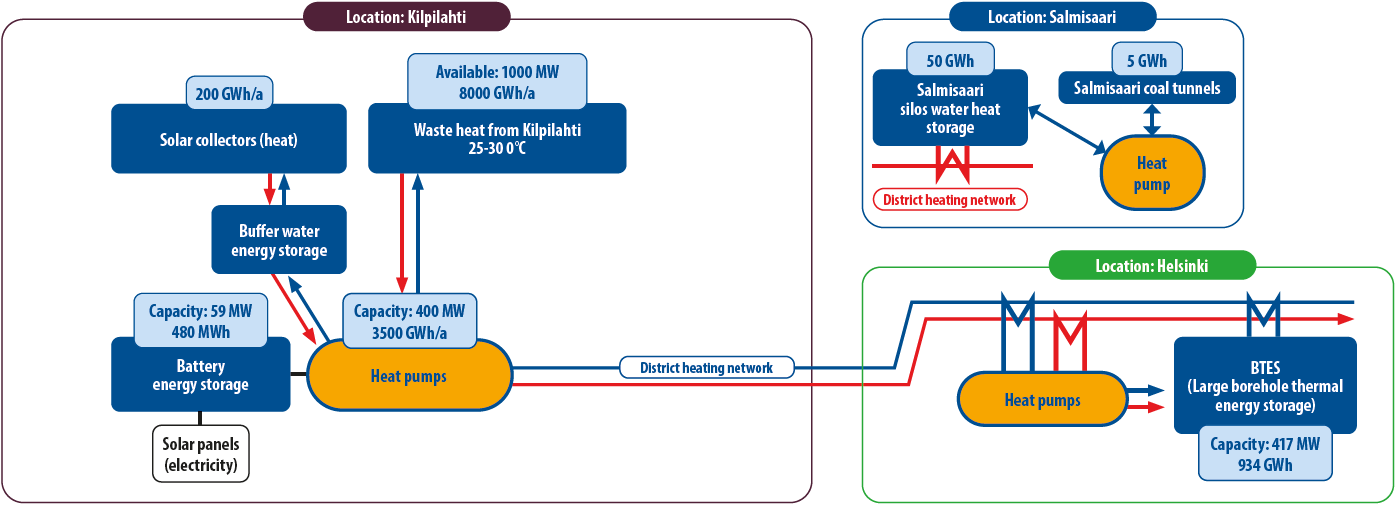14/01/2021
Getting rid of coal
Elomatic/TAMK proposal to Helsinki Energy Challenge
The phasing out of coal-fired powerplants by 2029 in Finland and the government’s pledge to become carbon neutral by 2035 poses challenges to the district heating system, where the burning of fuels has been the core heat source for decades. It is essential to already look beyond the first deadline of 2029 and prepare for continued efforts between 2029 and 2035.
Elomatic joined forces with the Tampere University of Applied Sciences in submitting a proposal to the Helsinki Energy Challenge, a competition held by the City of Helsinki to find the best sustainable heating alternatives.
When creating visions of a future district heating system that does not burn fuels, one must answer two key questions: where do we get the required heat, and how do we manage the significant variation in demand between winter and summer? For the first question, a careful examination of available heat sources reveals that if burning is undesirable, what remains is either diluted heat sources (geothermal, seawater) or a few existing centralized waste heat sources.
8 TWh of waste heat fed into the sea at Kilpilahti
Many studies have been conducted on the utilization of waste heat from the Kilpilahti industrial site. It is estimated that a total of 8 TWh of waste heat is fed into the ocean there each year, more than the total district heat consumption of Helsinki. Due to the vast amount of available heat and the good technical feasibility, it was selected as the backbone of the Elomatic/TAMK heat generation proposal.
The second fundamental question concerns overcoming the difference in consumption between summer and winter. Even though the industry in Kilpilahti produces 1000 MW of waste heat, it is nowhere near enough to cover the heat consumption on a cold winter day. In summer, however, the waste heat production is far more than the heat consumption. The solution to this mismatch is to construct a borehole thermal energy storage (BTES) system in Helsinki. Heat can be efficiently stored in the bedrock for long periods, and the bigger the storage is, the greater the overall efficiency is. BTES operation can be optimized with CFD simulations to minimize heat losses and to maximize the efficiency of heat pumps throughout the year.
Feeding waste heat via pipeline to Helsinki
In the Elomatic/TAMK proposal to the Helsinki Energy Challenge, the waste heat from Kilpilahti is primed with heat pumps and fed to Helsinki via a pipeline. The construction costs of the pipeline are estimated to be hundreds of millions of euros. To justify the high investment cost, the pipeline would have to be used at its maximum transfer capacity throughout the year. If a 400 MW pipeline were constructed, half of the transferred heat would be used to cover the district heating demand together with Katri Vala heat pumps during summer when demand is low. The rest of the transferred heat could be fed to BTES in Helsinki. In winter, all of the transferred heat and the stored heat in BTES would be used in the district heating network.
The pipeline and BTES, together with solar collectors and selected energy-saving measures, can fully compensate for the lost heat production due to the phasing out of coal-fired plants. The proposed solution would also more than halve the natural gas consumption and lower the fuel-based emissions of district heat production by 88%.

Overcoming the mismatch between energy production and consumption
There is a well-known mismatch between the consumption and production of renewable energy, both in terms of time and location. The sun does not shine in winter when a lot of energy is needed. Also, people do not want to have wind turbines in their backyards.
Some locations are known to be exceptionally sunny, windy, or to have strong wave action. A lot of renewable energy is available, if only the energy could be harvested, stored, and transferred to consumers. These energy-dense areas are typically located far away from densely populated ones.
The technologies for harvesting renewable energy are developing fast. PV panels and wind generators can be considered to be mature technologies. According to the IEA, solar energy is already the cheapest electricity in history. Wave generators are perhaps the most challenging to develop. The idea to place solar energy collectors in the desert is decades old. In contrast, floating energy fields in international waters are new and exciting, at least for countries/cities that do not have energy-dense areas within their borders. A floating energy field could consist of a combination of wind, wave, and solar collectors.
Use of aluminium in energy storage and transfer
A novel solution for energy storing and transfer is aluminium. With the help of renewable energy, aluminium oxide can be converted into metallic aluminium. Aluminium ingots are easy to store and transport, and their high energy density means that fewer ships and trucks and smaller storage areas are required. Aluminium’s energy content (roughly double that of diesel oil in the same volume) can be released by letting aluminium react with water, producing hydrogen gas, heat and aluminium oxide. The heat can be led to the district heating system and the hydrogen gas can be utilized, for instance, in public transportation.
Aluminium is not consumed in the process; it cycles in a closed loop. Aluminium oxide is transported back to the floating energy harvesting fields in international waters. All sea transportation is carried by emission-free cargo ships. The aluminium oxide is converted back to aluminium on floating aluminium factories close to the energy fields with the well-known Hall-Herlout process using the harvested electricity. Inert electrodes or biochar electrodes are used to avoid carbon emissions from the aluminium conversion process. The same ships transport aluminium back to the point of use. No special infrastructure is needed to store aluminium. It is a well-known, safe and widely accepted material that does not induce any risks or environmental hazards. Also, aluminium is one of the most abundant elements in the crust of the earth.
Borehole thermal energy storage is utilised to overcome the mismatch between energy production and consumption.
Carbon-neutral district heating
Aluminium can be used as an energy storage method that enables the carbon neutrality of Helsinki’s district heating. In the Elomatic/TAMK proposal to the Helsinki Energy Challenge, the City of Helsinki plays a key role in the development of Al-to-P technology. By acting early, Helsinki could become the hub of international Al-to-P research and development.
The combination of Katri Vala heat pumps, Kilpilahti waste heat, solar collectors, BTES and aluminium incineration can cover all of Helsinki’s district heating consumption. To reach carbon neutrality by 2035, a 430 MW aluminium incineration plant would be constructed and a total of 2000 GWh of district heat produced annually from carbon neutral aluminium. This would, in addition, set in motion a new global energy system based on aluminium energy storage that would help other cities and nations to replace fossil fuels in their district heating systems.


